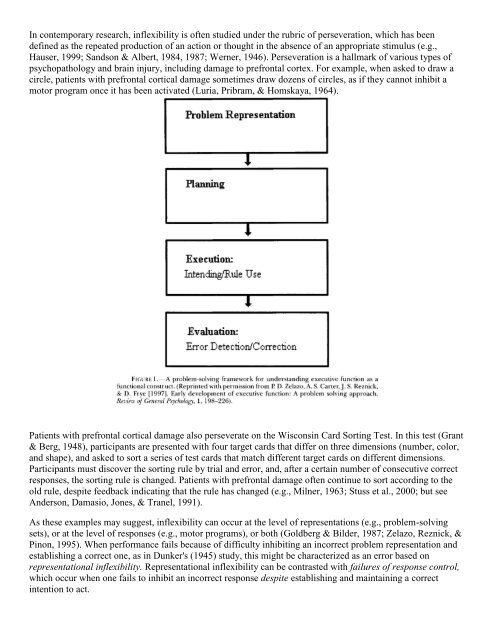THE DEVELOPMENT OF EXECUTIVE FUNCTION IN EARLY ...
THE DEVELOPMENT OF EXECUTIVE FUNCTION IN EARLY ...
THE DEVELOPMENT OF EXECUTIVE FUNCTION IN EARLY ...
You also want an ePaper? Increase the reach of your titles
YUMPU automatically turns print PDFs into web optimized ePapers that Google loves.
In contemporary research, inflexibility is often studied under the rubric of perseveration, which has been<br />
defined as the repeated production of an action or thought in the absence of an appropriate stimulus (e.g.,<br />
Hauser, 1999; Sandson & Albert, 1984, 1987; Werner, 1946). Perseveration is a hallmark of various types of<br />
psychopathology and brain injury, including damage to prefrontal cortex. For example, when asked to draw a<br />
circle, patients with prefrontal cortical damage sometimes draw dozens of circles, as if they cannot inhibit a<br />
motor program once it has been activated (Luria, Pribram, & Homskaya, 1964).<br />
Patients with prefrontal cortical damage also perseverate on the Wisconsin Card Sorting Test. In this test (Grant<br />
& Berg, 1948), participants are presented with four target cards that differ on three dimensions (number, color,<br />
and shape), and asked to sort a series of test cards that match different target cards on different dimensions.<br />
Participants must discover the sorting rule by trial and error, and, after a certain number of consecutive correct<br />
responses, the sorting rule is changed. Patients with prefrontal damage often continue to sort according to the<br />
old rule, despite feedback indicating that the rule has changed (e.g., Milner, 1963; Stuss et al., 2000; but see<br />
Anderson, Damasio, Jones, & Tranel, 1991).<br />
As these examples may suggest, inflexibility can occur at the level of representations (e.g., problem-solving<br />
sets), or at the level of responses (e.g., motor programs), or both (Goldberg & Bilder, 1987; Zelazo, Reznick, &<br />
Pinon, 1995). When performance fails because of difficulty inhibiting an incorrect problem representation and<br />
establishing a correct one, as in Dunker's (1945) study, this might be characterized as an error based on<br />
representational inflexibility. Representational inflexibility can be contrasted with failures of response control,<br />
which occur when one fails to inhibit an incorrect response despite establishing and maintaining a correct<br />
intention to act.
















